RISE OF NON-STATE TERRORISM
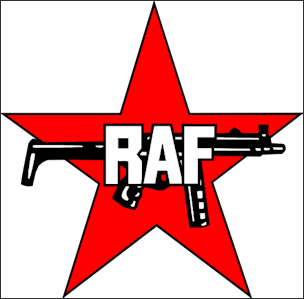
Red Army Faction logo The rise of guerrilla tactics by non-state actors in the last half of the twentieth century was due to several factors. These included the flowering of ethnic nationalism (e.g. Irish, Basque, Zionist), anti-colonial sentiments in the vast British, French and other empires, and new ideologies such as communism.[Source: PDF File, War and Terrorism, Deviance, Conflict and Social Management, January 1, 2012]
Terrorist groups with a nationalist agenda have formed in every part of the world. For example, the Irish Republican Army grew from the quest by Irish Catholics to form an independent republic, rather than being part of Great Britain.
Similarly, the Kurds, a distinct ethnic and linguistic group in Turkey, Syria, Iran and Iraq, have sought national autonomy since the beginning of the 20th Century. The Kurdistan Worker's Party(PKK), formed in the 1970s, uses terrorist tactics to announce its goal of a Kurdish state. The Sri Lankan Liberation Tigers of Tamil Eelam are members of the ethnic Tamil minority. They use suicide bombing and other lethal tactics to wage a battle for independence against the Sinhalese majority government.
Algerians militants, Palestinian fighters, the Italian Red Brigades, the German Red Army Faction, the Basque ETA, Colombian FARC, the Shining Path of Peru and the Tamil Tigers of Sri Lanka are among the 20th century groups that have been labeled as terrorist. The political activism and guerrilla tactics favored by Russian Bolsheviks, the Maoist insurgents, French Resistance and African National Congress were different.
Book: Blood and Rage: A Cultural History of Terrorism by Michael Burleigh (Harper/HarperCollins Publishers, 2009)
Terrorism Turns International
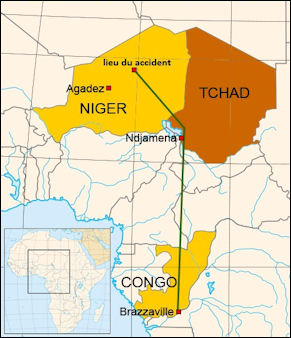
hijacked UTA Flight 772 International terrorism became a prominent issue in the late 1960s, when hijacking became a favored tactic. In 1968, the Popular Front for the Liberation of Palestine hijacked an an El Al Flight. Twenty years later, the bombing of a Pan Am flight over Lockerbie, Scotland, shocked the world. [Source: PDF File, War and Terrorism, Deviance, Conflict and Social Management, January 1, 2012]
The Rand Corporation's chronology of worldwide terrorism begins in 1968 (the year acknowledged as marking the advent of modern international terrorism, whereby terrorists attack other countries or foreign targets in their own country). In 1968 an El Al aircraft were hijacked.
In July 1968, Palestinian terrorists hijacked El Al Flight 426 as it flew from Rome to tel Aviv. The plane, which carried 10 crew members and 38 passengers, was diverted to Algiers. The hijackers — secular leftists — demanded the release of comrades imprisoned in Israel. Forty days of negotiations followed. The event received quite a lot of media attention. In the end the passengers were released unharmed. The hijacking is regarded by some as the beginning of modern terrorism. If nothing else it demonstrated that terrorism can be an effective marketing tool to bring attention to a cause that otherwise would be ignored in the media. Zehdi Lahib Terzi. The PLO’s United Nations observer, later told The New Yorker, the seizure of Flight 426 “awakened the media and public opinion much more...than 20 years of pleading.”
The era also gave us our contemporary sense of terrorism as highly theatrical, symbolic acts of violence by organized groups with specific political grievances. The bloody events at the 1972 Munich Olympics were politically motivated. Black September, a Palestinian group, kidnapped and killed Israeli athletes preparing to compete. Black September's political goal was negotiating the release of Palestinian prisoners. They used spectacular tactics to bring international attention to their national cause.
Munich radically changed the United States' handling of terrorism: "The terms counterterrorism and international terrorism formally entered the Washington political lexicon," according to counterterrorism expert Timothy Naftali.
During the Cold War, terrorist groups with anti-American and anti-West agenda, could move against their enemies by seeking the help of their enemy’s enemies, namely the Soviet Union. Terrorists also took advantage of the black market in Soviet-produced light weaponry, such as AK-47 assault rifles created in the wake of the Soviet Union's 1989 collapse. Most terrorist groups justified violence with a deep belief in the necessity and justice of their cause. When the Soviet Union collapsed the Soviet support was gone and anti-American groups realized they were on their own.
Terrorism in the United States also emerged. Groups such as the Weathermen grew out of the non-violent group Students for a Democratic Society. They turned to violent tactics, from rioting to setting off bombs, to protest the Vietnam War.
Terrorism in Europe in the 1960s, 70s and 80s
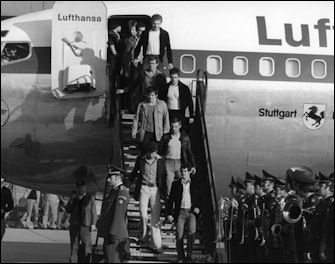
Lufthansa 151 In the spring and summer of 1968, when the Tet offensive escalated the war in Vietnam, Robert Kennedy and Martin Luther King were assassinated and demonstrations turned violent at the Democratic Convention in Chicago, there was also a lot of political unrest in Europe. Universities in Madrid and Rome were closed. Police and students clashed in West Germany. In France, a series of strikes lead by students brought the economy to its knees.
A student uprising in 1968 caused great chaos in Germany. Many young people in West Germany supported the Communist government in East Germany and bookstores opened up in German cities that specialized in works by Mao, Marx and Engles. In the spring of 1968 the leader of the largest student organization was shot, setting off arson attacks by the newly formed terrorist group called Red Army Faction.
Italy was the site of lot of terrorist activities in the 70s and 80s, including the shooting at Rome airport and the aboard a TWA flight. In 1969, 17 people killed from a bomb blast at a Milan bank. In 1980, 85 people killed and 200 were injured in a bombing in Bologna's train station.
Red Army Faction
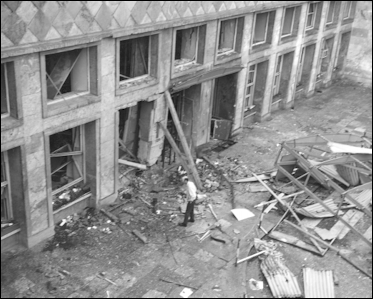
Terrace Club
Frankfurt Germany 1972 The extreme-left Red Army Faction was responsible for many terrorist attacks in the 1970s. Also known as the "Baader-Meinhof" gang, the name of two of its leaders, it targeted NATO and German political and industrial targets. Active between 1970 and 1993, the group promoted armed resistance and proletarian revolution and was driven by Marxism-Leninism ideology and was involved in numerous bombings and assassinations. Its most famous acts were the siege of the West German embassy siege and freeing its members from prison in 1970. [Source: Wikipedia]
The Red Army Faction (RAF) was founded in 1970 by Andreas Baader, Gudrun Ensslin, Horst Mahler, and Ulrike Meinhof. At that time it described itself as a communist and anti-imperialist "urban guerrilla" group engaged in armed resistance against what they deemed to be a fascist state. It was formed with the intention of complementing the plethora of revolutionary and radical groups across West Germany and Europe, as a more class conscious and determined force compared with some of its contemporaries. The members and supporters were already associated with the 'Revolutionary Cells' and Movement 2 June as well as radical currents and phenomena such as the Socialist Patients' Collective, Kommune 1 and the Situationists.
There were three successive incarnations of the organization, the "first generation" which consisted of Baader and his associates, the "second generation" RAF, which operated in the mid to late 1970s after several former members of the Socialist Patients' Collective joined, and the "third generation" RAF, which existed in the 1980s and 1990s. On 20 April 1998, an eight-page typewritten letter in German was faxed to the Reuters news agency, signed "RAF" with the submachine-gun red star, declaring that the group had dissolved.
The Red Army Faction was especially active in late 1977, which led to a national crisis that became known as "German Autumn". It was held responsible for thirty-four deaths, including many secondary targets, such as chauffeurs and bodyguards, and many injuries. Although better-known, the RAF conducted fewer attacks than the Revolutionary Cells (RZ), which is held responsible for 296 bomb attacks, arson and other attacks between 1973 and 1995.
Baader and Meinhof
.jpg)
Ulrike Meinhof In the spring of 1968 Andreas Baader was arrested for his involvement in setting fire to two department stores in Frankfurt to protest against the Vietnam war. Afterwards he said, "If one sets a car on fire, that is a criminal offence. If one sets hundreds of cars on fire, that is political action." His trial was big news. Baader was arrested again in April 1970, but on 14 May 1970 he was freed by Meinhof and others Although Meinhof was not considered to be a leader of the RAF at any time, her involvement in Baader's escape from jail and her well-known status as a German journalist led to her name becoming attached to it. [Source: Wikipedia]
After the 1970 prions break Baader, Ensslin, Mahler, and Meinhof then went to Jordan, where they trained in the West Bank and Gaza with Popular Front for the Liberation of Palestine (PFLP) and Palestine Liberation Organization (PLO) guerrillas and looked to the Palestinian cause for inspiration and guidance. But RAF organisation and outlook were also partly modeled on the Uruguayan Tupamaros movement, which had developed as an urban resistance movement, effectively inverting Che Guevara's Mao-like concept of a peasant or rural-based guerrilla war and instead situating the struggle in the metropole or cities.
When they returned to West Germany, they began what they called an "anti-imperialistic struggle", with bank robberies to raise money and bomb attacks against U.S. military facilities, German police stations, and buildings belonging to the Axel Springer press empire. In 1970, a manifesto authored by Meinhof used the name "RAF" and the red star logo with a Heckler & Koch MP5 submachine gun for the first time.
Despite killing 34 people, Baader-Meinhof garnered a degree of support from the West German population. According to Fred Siegel, the group of militants began to be accepted, if not always admired, by "guilt-ridden liberals", who saw its panache as a countercultural critique of West Germany's "boring bourgeois life" and who resented their nation's association with the American war in Vietnam. Siegel asserts that Baader-Meinhof seized on this sentiment and carefully cultivated an outlaw image, wholesaling the ideal of authentically acting out one's impulses, in order to break through "the fascism of convention", just as its heroes abroad like Che Guevara supposedly "broke through the iron wall of America imperialism."Drawing on its New Left counterparts in the United States, the group even began to borrow such phrases as "burn baby burn," "right on", and "off the pigs". After an intense manhunt, Baader, Ensslin, Meinhof, Holger Meins, and Jan-Carl Raspe were eventually caught and arrested in June 1972.
Red Brigade
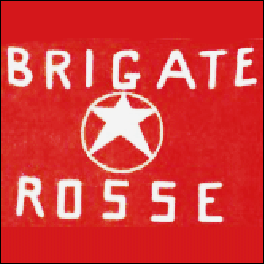
Italy's Communist Red Brigade has been called the most successful European terrorists group ever. It pioneered the practice of kneecapping and took the lives of 350 people during its campaign of political assassinations and kidnappings. One magistrate still walks with a limp today as result of four red Brigade bullets that were pumped into his knee at close range in 1979.
The Red Brigade was founded in 1972 and made headlines the next year with the kidnapping of a prominent businessman and a judge. The group thrived during a period of political turmoil in Italy and was tacitly supported by the Italian Left. The Red Brigade’s symbol was a five-pointed star in a circle.
The Red brigade also managed to capture a an American NATO general and killed an American who headed a peacekeeping force on the Sinai. The period of violence associated with the group was known as "years of lead."
In the 1980s the Red Brigade was "systematically dismantled" over a period a couple of years, thanks in part to tough laws. More than 250 Red Brigade members and their followers were jailed Red Brigade leader Alessio Casimirri was sentenced in Italy to four life terms for assisting the Red Brigade in their plot to kidnap and kill Prime Minister Aldo Moro in 1978 (See Below). He was pardoned after 17 years in prison.
In May 1999, when it had ben thought the Red Brigade was dead and buried, it reemerged as a group called Construction of a Combative Communist Party and killed Massimo D'Antona, a top level economic advisor for primer Minister Massimo D'Alema. The killers calmly shot D'Antona, pocketed their silencers and dropped their guns, and walked away. The 1999 attack was followed by a 20-page letter to a Roman newspaper denounce United States militarism, NATO activities and welfare cuts. The letter contained the Red Brigade symbol.
Aldo Moro Murder Case
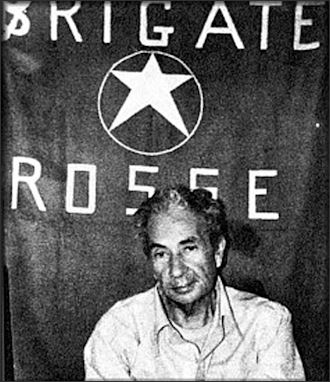
Aldo Moro On March 16, 1978, Aldo Moro, the recently named Prime Minister of Italy, was kidnapped by terrorists from the Red Brigade while he was on his way to a celebration of an alliance between the Christian Democrats, , the leading political forces in Italy at that time, and Communists. Five of Moro’s bodyguards were murdered during the ambush of motorcade and abduction to a people's prison in a Rome apartment.
The government refused to negotiate with the terrorists. Fifty-five days later Moro’s mutilated body was found in the trunk in a car parked around the corner for the headquarters of both Communist and Christian Democrats. According to some reports. Moro's body was dropped exactly halfway between the headquarters for the Christian Democrats and the Communists. In fact it was dropped between the American studies library and U.S. cultural attaché residence.
"By killing Moro," American scholar Alexander Stille wrote in the New York Times, "the Red Brigade hoped to destroy the historic compromise, whose reformist, social-democratic agenda appeared to be the greatest obstacle to revolution. But the Moro murder boomeranged on the terrorist movement. The Red Brigade had been badly split over the decision to kill Moro and soon began to suffer major defections from its ranks. The case shook the beliefs of those Italians who remained infatuated with armed revolt and galvanized public opinion against terrorism."
The decision to kill Moro was done after a poll was taken among 200 members of the gang. The convicted triggerman in Moro murder, Mario Moretti, blamed the Italian government for not negotiating. He said that "just a signal, the recognition of the existence of political prisoners" would have been enough.
The Moro Murder dealt the Communist Party a damaging blow and help pushed public sentiment towards the right. Some Italian conspiracy theorists have suggested that maybe the Italian government, possible in cahoots with the C.I.A. or the Mafia, put the Red Brigade up to the murder to help the Christian Democrats. These suggestions have been largely discredited.
Book: “Aldo Moro Murder Case” by Richard Drake (Harvard University Press, 1995)
Japanese Red Army
In the 1970s, the Japanese Red Army (JRA) was one of the world's most notorious terrorist groups. Initially a splinter group of the extreme left-wing United Red Army, the group was founded by Fusako Shigenobu in 1969 and was made up of radicals from student groups who protested the presence of U.S. military based in Japan. The goal of the group was to overthrow the Japanese government, eliminate the monarchy and foment world revolution.
In the early 1970s, the Red Army broke into factions. Shigenobu moved her faction to war-torn Lebanon and set up a commune, which allied itself with the Popular Front for the Liberation of Palestine and for fun held nightly self-criticism sessions. Pursued by Israeli agents they were constantly on the run. Even so Shigenobu had a daughter, with a Palestinian terrorist, who she raised with the help of other Red Army members and Arab supporters.
Japanese Red Army Activities and North Korea

scene from the film United Red Army In 1970, nine Japanese Red Army member hijacked a Japan Airlines domestic flight, with 138 people on board, to North Korea. During this hijacking the plane landed at Seoul, where a North Korean flag was raised in attempt to trick the hijackers into thinking the plane had landed in Pyongyang. The trick didn't work. The hijackers became suspicious after U.S. airliners were spotted at the airport. The 129 passengers and cabin crew on board were released in Seoul. The plane continued on to Pyongyang, where the nine defected.
The Yodo-go incident was the first hijacking in Japan. One of the Red Army Faction members, Yasuhiro Shibata, was only 16. The plane was on a domestic flight from Tokyo to Fukuoka on March 31, 1970. Yodo-go was the name of the airplane.
The hijackers were granted political asylum. They were welcomed by Kim Il Sung as heroes and initially were feted to privileges like housing in a special revolution village and chauffeured Mercedes-Benz cars.. The hijackers married Japanese women secretly brought into the country. Over time their privileges were taken away and they lived under strict rules imposed by North Korea. Many become idle and bored.
Four of the Yodo hijackers remain in North Korea and will probably stay there. The Japanese government wants to talk to them because they could help answer some unanswered question about the abduction of Japanese citizens by North Korea. Of the 20 children born to Yodo hijackers all are living in Japan. All the hijacker wives live in Japan with the exception of two that remain in North Korea.
Japanese Red Army Activities in Japan
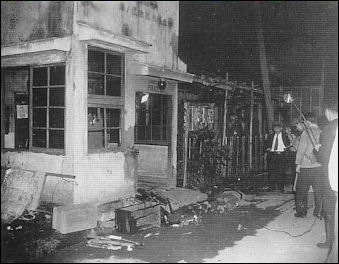
Iwanosaka Koban Incident
The Red Army executed 14 people in Japan between August 1971 and February 1972 and had shootouts with Japanese police. There were also believed to have had a hand in a 1974 bombing of Mitsubishi Heavy Industries in the central Tokyo business district that killed eight people and injured nearly 400 (this was last major terrorist incident in Japan before the Aum Shinrokyo poison gas subway attack in 1995).
Hiroko Nagata was a United Red Army member who was involved in the mass murder of her comrades in the early 1970s. According to court findings, Nagata conspired with other members of the radical group in the August 1971 murders of two members who tried to leave. She was also involved in the mass killing of 12 more members in a mountainous area of Gunma prefecture between December 1971 and February 1972 over ideological differences.
The Asama Sanso incident was the name given to 10-day stand-off in March 1972 between five Red Army members and police at the Asama Sanso mountain resort in Karuizawamachi, Nagano Prefecture. After Nagata’s arrest in February 1972, five members of the group, including Hiroshi Sakaguchi, 64, barricaded themselves into the Asama Lodge in Karuizawa, Nagano Prefecture, taking the wife of the lodge manager hostage. The ensuing gun battles with police, in which three officers were killed, were played out in front of television cameras over the following 10 days.
The incident began when the Red Army members quietly entered the lodge and took the wife of the lodgekeeper hostage. Police tracked the terrorists to the lodge following their footprints in the snow. A shoot-out took place when the terrorists were cornered by police. During the standoff 1,000 police took up positions around the lodge and sprayed the lodge with water cannons to to keep the terrorists from firing. The incident ended when the police stormed the lodge and rescued the hostage after smashing the walls with a wrecking ball. Two police and one member of the public died. .
Japanese Red Army Activities in Europe and the Middle East

Japanese terrorists hold the
the French embassy in The Hague On May 30, 1972, three members of the JRA grabbed two suitcases from a conveyor belt in the passenger lounge of the Tel Aviv airport, pulled out submachine guns and grenades and opened fire into a crowd, killing 24 civilians, including 16 Puerto Ricans on a religious pilgrimage, and wounded 76. All of the terrorist were killed except for one, Kozo Okamoto, who was captured and imprisoned by Israeli authorities (See Below).
The Red Army was also involved in seizures at the French embassy in the Hague in 1974 and the Swedish and U.S. embassies in Kuala Lumpur in 1975 as part of efforts to win the release of jailed members.
The greatest hijacking ransom ($6 million) was paid by the Japanese government to the hijackers of a JAL flight with 38 hostages at Dacca Airport in Bangladesh in October 1977. The Red Army hijacked Paris-bound Japan Airlines over India. The government gave into the demands of the hijackers to win the release of the 156 passengers and get back the plane. The Prime Minister said, “Human life is weightier than the earth.” Six Red Army members were released. In 1973, JAL flight was redirected to Libya and the plane was blown up after the passengers were freed.
The Red Army is believed to have worked with other international revolutionary groups such as the Red Brigade in Italy and the Baade-Meinhof Gang in Germany. In April 1988, the Red Army detonated a bomb in Naples as part of an anti-American campaign but was pretty quiet after that. Since the end of the Cold War the group has had difficulty securing funds.
Religious Terrorism and Beyond
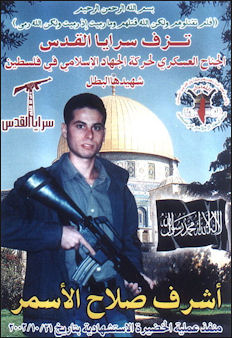
Glorifying Suicide Bomber Religiously motivated terrorism is considered the most alarming terrorist threat today. Groups that justify their violence on Islamic grounds — Al Qaeda, Hamas, Hezbollah — come to mind first. But Christianity, Judaism, Hinduism and other religions have given rise to their own forms of militant extremism. [Source: PDF File, War and Terrorism, Deviance, Conflict and Social Management, January 1, 2012]
In the view of religion scholar Karen Armstrong this turn represents terrorists' departure from any real religious precepts. Muhammad Atta, the architect of the 9/11 attacks, and "the Egyptian hijacker who was driving the first plane, was a near alcoholic and was drinking vodka before he boarded the aircraft." Alcohol would be strictly off limits for a highly observant Muslim. Atta, and perhaps many others, are not simply orthodox believers turned violent, but rather violent extremists who manipulate religious concepts for their own purposes.
A poll in six Arabs nation in 2005 found 78 percent of the respondents felt that there was more terrorism since the United States invasion of Iraq in 2003.
See Al-Qaida, Osama bin Laden
Terrorism After September 11th
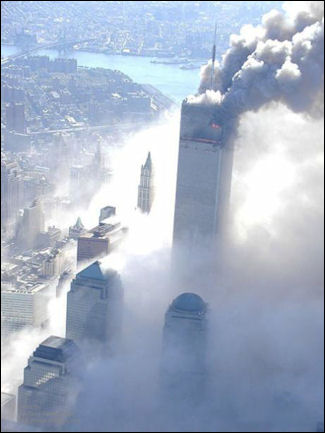
Terrorism has tended to be more of bottom rather than top down movement since September 11th. Forensic psychologist Marc Sageman wrote in the Los Angeles Times: “There is no fixed number of individuals who are terrorists. Rather, there are a few full-time terrorists among a pool of people sympathetic to their ideology. The number available to carry out acts of terrorism fluctuates according to local grievances and the international situation. Far from having a formal command, wherein follower strictly obey orders, these networks are self-organized....and demonstrate a great deal of local initiative.”
Flexibility and adaptability are important in terrorism. Participants often are from a variety of backgrounds and come together for different reasons. If a terrorist or a terrorist leader is killed for the group to stay alive someone has to be willing to step in and take their place
Few terrorists today have been trained at camps like the ones Al-Qaida ran in Afghanistan. Often they learn what they know from the Internet and small community based groups sometimes associated with local mosques.
On the topic of jihadist s who attack Western targets, a Muslim theologian told Reuters: “There are fanatic people who feel they have been humiliated, who seek any justification for their wish to take revenge. The nearest thing to their mind, the only philosophy we have, is Islam. So they draw their justification from their misunderstanding of Islamic principles."
See Al-Qaida, Osama bin Laden
Image Sources: Wikimedia Commons
Text Sources: New York Times, Washington Post, Los Angeles Times, Times of London, The Guardian, National Geographic, The New Yorker, Time, Newsweek, Reuters, AP, AFP, Wall Street Journal, The Atlantic Monthly, The Economist, Global Viewpoint (Christian Science Monitor), Foreign Policy, Wikipedia, BBC, CNN, NBC News, Fox News and various books and other publications.
Last updated July 2012
